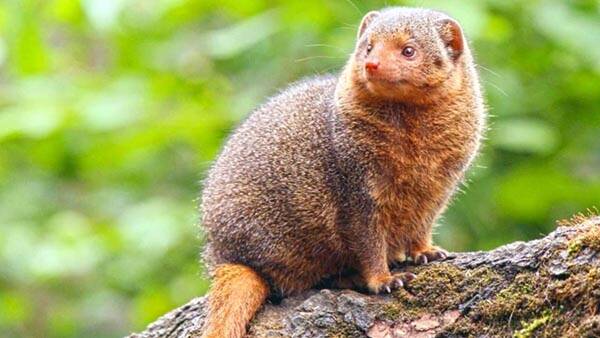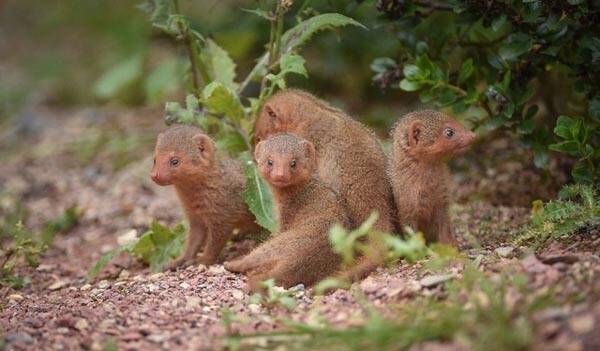Helogale parvula,Dwarf mongoose
IUCN
LCBasic Information
Scientific classification
- name:Helogale parvula,Dwarf mongoose
- Scientific Name:Helogale parvula
- Outline:Carnivora
- Family:Meerkatidae mongoose
Vital signs
- length:18-28cm
- Weight:210-350g
- lifetime:10-13years
Feature
One of the smallest mongooses in the world
Distribution and Habitat
It is mainly distributed in Africa, from southern Congo, Mozambique, Zambia, Angola to eastern Namibia, Botswana and a small part of northern South Africa. It lives in a variety of habitats densely populated with termite nests, including dry and moist wooded savannas, shrubs, shrubs and open woods, and sometimes appears in pastoral areas.
Appearance
The dwarf mongoose is generally 18-28 cm long and weighs 210-350 grams.
The dwarf mongoose is a typical mongoose with a pointed head, small ears, long tail, short limbs, and long claws. It is much smaller than the average mongoose. Its fur is soft, generally reddish brown or dark brown, and its limbs and abdomen are lighter in color. There are spots on the back. Some are mixed with light gray and brown, with brown-yellow limbs, and there is a fine line on both sides of the head from the corner of the mouth through the cheek to the shoulder; the body and tail hair are thick, long, fluffy, and the hair is sparse.
Details
The dwarf mongoose (scientific name Helogale parvula) is a small carnivore in Africa and a snake nemesis.

The dwarf mongoose is docile and lives mainly in dry grasslands, open forests or shrub areas, and sometimes near buildings. They can live at an altitude of up to 2,000 meters. They like to live in valleys and streams in mountains and forests, and often use tree holes and rock crevices as nests. The caves usually have several entrances. They go out of the caves to forage in the morning or evening, and are generally active at night. They feed on insects (mainly beetle larvae, termites, locusts and crickets), small lizards, snakes, small birds and rodents, and occasionally eat berries.
Dwarf mongooses are social animals, with a population size ranging from 2 to 20, and the number of female mongooses is greater than that of male mongooses. The population has a strict hierarchy, with a pair of leading mongooses. The leading female mongoose is the leader of the entire population, and the male mongoose is mainly responsible for exploring the nearby situation. Male and female mongooses often accompany each other and have the habit of helping each other. Dwarf mongoose populations often show altruistic behavior. When other mongooses are foraging or playing, one or more members will stand guard to observe possible dangers. When a predator is spotted, the sentinel will sound a warning, and the other members can quickly flee or hide in the burrow. After that, the sentinel will be the first to emerge from the burrow to observe the situation and continue to warn the other members to stay in the burrow. After the threat is eliminated, the sentinel will stop the warning call, and the other members can safely emerge. Individuals in the same group will often groom each other's fur to strengthen social relationships. The spouse of the low-ranking meerkat (this is unclear) will often leave scent marks on the group members to declare their authority. Such actions are usually accompanied by the low-ranking members combing their fur to show goodwill. Such actions are also often carried out when the group members reunite. Most of the group members are the brothers, sisters or children of the leader.
Dwarf mongooses also look after the young in their herd. Unfertilized females will breastfeed the young when the female in a lower leadership position is not around (this is questionable, unfertilized females should not be able to breastfeed), and they will protect the young from any threat, even if it threatens their lives. The nanny will lead the young to the cave to avoid predators. If they cannot hide underground, the nanny will gather the young and use her body to block them. When the mother takes her cubs out for a walk, she often makes a cooing sound to lead the way.
Dwarf mongooses have an extremely sensitive sense of smell. When they find earthworms or insect larvae underground, they immediately use their front paws and snout to dig in the soil. Dwarf mongooses are known to engage in some strange activities, including some activities that look like wrestling or racing.

The dwarf mongoose does make people feel a little unknown, and they would never think that it is actually the natural enemy of snakes. After all, the largest mongoose is basically only about one meter long, which is about the length of an average person's thigh. Mongooses like to live in groups, and you can often see them standing together in the wild to bask in the sun. Although the upright posture makes people feel that this is a very alert little guy, it always gives people a "cute" feeling first. People who don't know it will never associate it with a "ferocious beast". What is unexpected is that even the daunting king cobra is not its opponent at all. A zoologist once saw a king cobra more than three meters long being chased and fled by a small mongoose during a field survey. You know, even Elephants-Are-Endangered.html">elephants are afraid of that thing, but in the end it still died at the hands of the small mongoose. It sounds a bit incredible, but the mongoose still has its unique ability to catch snakes, and the most important thing is its agility. At first, the snake was quite majestic, especially the cobra's bulging head, which looked like it was looking down from a high position. The mongoose, however, was not in a hurry to attack. It knew the nature of its opponent too well, so it easily avoided every attack from the snake until it was exhausted. Then it suddenly pounced on the snake like lightning and bit the snake's head tightly. Its sharp teeth could crush the snake's skull in one go, killing it, while the mongoose had a good meal.
Widely distributed in Africa, with strong adaptability, the population density is very high in some areas, and it is distributed in many nature reserves. As a species, there is no serious threat.
Protect wild animals and eliminate game.
Maintaining ecological balance is everyone's responsibility!








